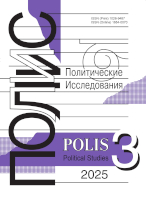The Share of Youth in the Total Population as a Factor of Intensity of Non-Violent Protests:
A Quantitative Analysis
Romanov D.M.,
HSE University, Moscow, Russia, dm.romanov@me.com
ORCID: 00000-0001-9052-5019 |Meshcherina K.V.,
HSE University, Moscow, Russia, k.meshcherina@hotmail.com
elibrary_id: 779127 | ORCID: 0000-0002-7447-1521 | RESEARCHER_ID: D-9527-2017
Korotayev A.V.,
HSE University, Moscow, Russia; Lomonosov Moscow State University, Moscow, Russia, akorotayev@gmail.com
elibrary_id: 72980 | ORCID: 0000-0003-3014-2037 | RESEARCHER_ID: N-1160-2018
DOI: 10.17976/jpps/2021.03.11
Romanov D.M., Meshcherina K.V., Korotayev A.V. The Share of Youth in the Total Population as a Factor of Intensity of Non-Violent Protests: A Quantitative Analysis. – Polis. Political Studies. 2021. No. 3. https://doi.org/10.17976/jpps/2021.03.11
This article was prepared in the framework of the HSE University Fundamental Research Program in 2020 with financial support provided by the Russian Science Foundation, Project No. 18-18-00254. The authors express their gratitude to S.A. Nikiforova for invaluable help in the preparation of this article.
Studies in political demography suggest that there should be a positive correlation between the increased share of youth in the total population (‘youth bulges’) and the intensity of anti-government demonstrations. However, a correlation analysis (without adding any control variables) between the youth bulges and the intensity of non-violent protests demonstrates unexpected results: in this case, a statistically significant negative correlation is identified instead. It is shown that this is due to sociopolitical, sociocultural, and economic modernization factors. In the long run, modernization – through a decrease in the birth rate and an increase in life expectancy – leads to the population ageing and a reduction in the share of youth in the total adult population, which by itself acts as a factor in reducing the intensity of anti-government demonstrations. Nevertheless, on the other hand, modernization gives rise to other powerful factors, such as democratization, urbanization, and the expansion of formal education, which are more than able to compensate for the ‘youth bulge’ decline. These theoretical expectations have been confirmed by our tests. After the introduction of respective control variables, ‘youth bulges’ turn out to be a factor increasing the intensity of protests, yet without these controls they become a predictor of the relatively low intensity of non-violent protests. Thus, our tests show that a high proportion of young people in the total population, all other things being equal, is still a factor in the increased intensity of anti-government demonstrations; without a decrease in ‘youth bulges’, modernization would have led to a significantly more pronounced increase in the intensity of non-violent protests.
References
Ang A.U., Shlomi D., Russell E.L. 2014. Protests by the Young and Digitally Restless: The Means, Motives, and Opportunities of Anti-Government Demonstrations. – Information, Communication & Society. Vol. 17. No. 10. P. 1228-1249. https://doi.org/10.1080/1369118X.2014.918635
Banks A., Wilson K.A. 2019. Cross-National Time-Series Data Archive. Jerusalem: Databanks International. URL: http://www.databanksinternational.com (accessed 01.09.2019).
Barnes S.H., Kaase M. 1979. Political Action. Mass Participation in Five Western Democracies. Beverly Hills, CA: Sage.
Barro R.J. 1991. Economic Growth in a Cross Section of Countries. – The Quarterly Journal of Economics. Vol. 106. No. 2. P. 407-443. https://doi.org/10.2307/2937943
Barro R.J., Lee J.W. 2015. Education Matters. Global Schooling Gains From the 19th To the 21st Century. Oxford: Oxford University Press.
Benos N., Zotou S. 2014. Education and Economic Growth: A Meta-Regression Analysis. – World Development. Vol. 64. P. 669-689. https://doi.org/10.1016/j.worlddev.2014.06.034
Caldwell J.C. 2006. Demographic Transition Theory. Dordrecht: Springer.
Chesnais J-C. 1992. The Demographic Transition: Stages, Patterns, and Economic Implications. Oxford: Oxford University Press.
Collier P., Hoeffler A. 2004. Greed and Grievance in Civil War. – Oxford Economic Papers. Vol. 56. No. 4. P. 563-595. https://doi.org/10.1093/oep/gpf064
Coppedge M., Gerring J., Knutsen C.H., Lindberg S.I., Skaaning S-E., Teorell J., Altman D., Bernhard M., Fish M.S., Cornell A., Dahlum S., Gjerlow H., Glynn A., Hicken A., Krusell J., Luhrmann A., Marquardt K.L., McMann K., Mechkova V., Medzihorsky J., Olin M., Paxton P., Pemstein D., Pernes J., von Romer J., Seim B., Sigman R., Staton J., Stepanova N., Sundstrom A., Tzelgov E., Wang Yi-t., Wig T., Wilson S., Ziblatt D. 2018. V-Dem Codebook v8. – Varieties of Democracy (V-Dem) Project.
Dahl R.A. 1971. Polyarchy: Participation and Opposition. New Haven: Yale University Press.
Dahl M., Gates S., Gleditsch K.S., Gonzalez B. 2014. Accounting for Numbers: Actor Profiles and Violent and Non-Violent Tactics. Oslo: Peace Research Institute Oslo.
Dyson T. 2013. Population and Development: The Demographic Transition. London: Zed Books Ltd.
Epstein D.L., Bates R., Goldstone J., Kristensen I., O’Halloran S. 2006. Democratic transitions. – American Journal of Political Science. Vol. 50. No. 3. P. 551-569. https://doi.org/10.1111/j.1540-5907.2006.00201.x
Farzanegan M.R., Witthuhn S. 2017. Corruption and Political Stability: Does the Youth Bulge Matter? – European Journal of Political Economy. No. 49: P. 47-70. https://doi.org/10.1016/j.ejpoleco.2016.12.007
Fearon J.D., Laitin D.D. 2003. Ethnicity, Insurgency, and Civil War. – American Political Science Review. Vol. 97. No. 1. P. 75-90. https://doi.org/10.1017/S0003055403000534
Fluckiger M., Ludwig M. 2018. Youth Bulges and Civil Conflict: Causal Evidence from Sub-Saharan Africa. – Journal of Conflict Resolution. Vol. 62. No. 9. P. 1932-1962. https://doi.org/10.1177/0022002717707303
Fuller G.E. 2004. The Youth Crisis in Middle Eastern Society. Clinton Township: Institute of Social Policy and Understanding.
Gleditsch K.S., Rivera M. 2017. The Diffusion of Nonviolent Campaigns. – Journal of Conflict Resolution. Vol. 61. No. 5. P. 1120-1145. https://doi.org/10.1177/0022002715603101
Goldstone J.A. 1991. Revolution and Rebellion in the Early Modern World. Berkeley, CA: University of California Press.
Goldstone J.A. 2002. Population and Security: How Demographic Change Can Lead to Violent Conflict. – Journal of International Affairs. Vol. 56. No. 1. P. 3-21.
Goldstone J.A., Bates R.H., Epstein D.L., Gurr T.R., Lustik M.B., Marshall M.G., Ulfelder J., Woodward M. 2010. A Global Model for Forecasting Political Instability. – American Journal of Political Science. Vol. 54. No. 1. P. 190-208. https://doi.org/10.1111/j.1540-5907.2009.00426.x
Gould W. 2015. Population and Development. London: Routledge.
Heinsohn G. 2003. Sohne und Weltmacht: Terror im Aufstieg und Fall der Nationen. Zurich: Orell Fussli. Hilbe J.M. 2011. Negative Binomial Regression. Cambridge: Cambridge University Press.
Huntington S.P. 1996. The Clash of Civilizations and the Remaking of World Order. New York, NY: Simon & Schuster.
Jenkins J.C., Wallace M. 1996. The Generalized Action Potential of Protest Movements: The New Class, Social Trends, and Political Exclusion Explanations. – Sociological Forum. Vol. 11. No. 2. P. 183-207. https://doi.org/10.1007/BF02408364
Korotayev A., Bilyuga S., Shishkina A. 2018. GDP per Capita and Protest Activity: A Quantitative Reanalysis. – Cross-Cultural Research. Vol. 52. No. 4. P. 406-440. https://doi.org/10.1177/1069397117732328
Korotayev A., Zinkina J., Goldstone J.A. 2015. Phases of Global Demographic Transition Correlate with Phases of the Great Divergence and Great Convergence. –Technological Forecasting and Social Change. Vol. 95. P. 163-169. https://doi.org/10.1016/j.techfore.2015.01.017
Lia B. 2007. Globalisation and the Future of Terrorism: Patterns and Predictions. London: Routledge. Lipset S.M. 1959. Some Social Requisites of Democracy: Economic Development and Political Legitimacy. – American Political Science Review. Vol. 53. No. 1. P. 69-105. https://doi.org/10.2307/1951731
Londregan J.B., Poole K.T. 1996. Does High Income Promote Democracy? – World Politics. Vol. 49. P. 1-30. https://doi.org/10.1353/wp.1996.0024
Lutz W., Qiang R. 2002. Determinants of Human Population Growth. – Philosophical Transactions of the Royal Society of London. Series B: Biological Sciences. Vol. 357. No. 1425. P. 1197-1210. https://doi.org/10.1098/rstb.2002.1121
Maddison А. 2010. World Population, GDP and Per Capita GDP, A.D. 1–2008. Database. URL: www.ggdc.net/maddison (accessed 01.05.2019).
Marshall M.G., Gurr T.R., Jaggers K. 2016. Polity IV Project: Political Regime Characteristics and Transitions, 1800-2013. Vienna, VA: Center for Systemic Peace.
Nordas R., Davenport C. 2013. Fight the Youth: Youth Bulges and State Repression. – American Journal of Political Science. Vol. 57. No. 4. P. 926-940. https://doi.org/10.1111/ajps.12025
Preston S.H. 1979. Urban Growth in Developing Countries: A Demographic Reappraisal. – Population and Development Review. Vol. 5. No. 2. P. 195-215. https://doi.org/10.2307/1971823
Przeworski A., Limongi F. 1997. Modernization: Theories and facts. – World Politics. Vol. 49. No. 2. P. 155-183. https://doi.org/10.1353/wp.1997.0004
Sala-i-Martin X., Doppelhofer G., Miller R.I. 2004. Determinants of Long-Term Growth: A Bayesian Averaging of Classical Estimates (BACE) Approach. – American Economics Review. Vol. 94. No. 4. P. 813-835. https://doi.org/10.1257/0002828042002570
UN Population Division. 2019. World Population Prospects 2019. URL: https://population.un.org/wpp/Download/Standard/Population/ (accessed 02.05.2019).
Urdal H. 2004. The Devil in the Demographics: The Effect of Youth Bulges on Domestic Armed Conflict, 1950-2000. Washington, DC: World Bank.
Urdal H. 2006. A Clash of Generations? Youth Bulges and Political Violence. – International Studies Quarterly. Vol. 50. No. 3. P. 607-629. https://doi.org/10.1111/j.1468-2478.2006.00416.x
Urdal H. 2008. Population, Resources, and Political Violence: A Subnational Study of India, 1956-2002. – Journal of Conflict Resolution. Vol. 52. No. 4. P. 590-617. https://doi.org/10.1177/0022002708316741
Urdal H., Hoelscher K. 2012. Explaining Urban Social Disorder and Violence: An Empirical Study of Event Data From Asian and Sub-Saharan African Cities. – International Interactions. Vol. 38. No. 4. P. 512-528. https://doi.org/10.1080/03050629.2012.697427
Weber H. 2019. Age Structure and Political Violence: A Re-Assessment of the “Youth Bulge” Hypothesis. – International interactions. Vol. 45. No. 1. P. 80-112. https://doi.org/10.1080/03050629.2019.1522310
Korotayev A.V., Bilyuga S.E., Shishkina A.R. 2016. GDP per Capita, Protest Intensity and Regime Type: A Quantitative Analysis. – Comparative Politics Russia. Vol. 7. No. 4. P. 72-94. (In Russ.) https://doi.org/10.18611/2221-3279-2016-7-4(25)-72-94
Korotayev A.V., Vaskin I.A., Bilyuga S.E. 2017. Olson-Huntington Hypothesis on a Bell-Shaped Relationship Between the Level of Economic Development and Sociopolitical Destabilization: A Quantitative Analysis. – Russian Sociological Review. Vol. 16. No. 1. P. 9-47. (In Russ.)
Vishnevskiy A.G. 2005. Demograficheskaya teoriya i demograficheskaya istoriya [Demographic theory and Demographic History]. – Izbrannye demograficheskie trudy [Selected Works on Demography]. Vol. 1. Moscow: Nauka. (In Russ.)
See also:
Bolshakov A.G.,
Our political transformation: the completion or a pause?. – Polis. Political Studies. 2013. No2
Kulpin E.S.,
The globalizing world and political modernization. – Polis. Political Studies. 2013. No3
Grinin L.Ye., Korotayev A.V.,
Urbanization and Political Instability: to the Development of Mathematical Models of Political Processes. – Polis. Political Studies. 2009. No4
Round Table of the «Polis» Journal, Smirnov V.V., Popova O.V., Smorgunov L.V., Shashkova Ja.Ju., Baranov N.A., Karabushchenko P.L.,
Where will Russia go? New opportunities and restrictions of modern development. Part II. – Polis. Political Studies. 2013. No2
Round Table of the «Polis» Journal, Makarenko B.I., Solovyov A.I., Nikovskaya L.I., Kochetkov A.P., Timofeyeva L.N., Petukhov V.V., Glukhova A.V., Smirnov V.V., Popova O.V., Smorgunov L.V., Shashkova Ja.Ju., Baranov N.A., Karabushchenko P.L.,
Where will Russia go? new opportunities and restrictions of modern development. Part I. – Polis. Political Studies. 2013. No1





.jpg)






 print
print
.jpg)
.jpg)